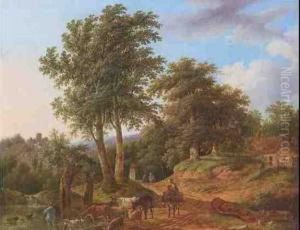Antoon Pieter Steyaert Paintings
Antoon Pieter Steyaert was a Flemish sculptor known for his work during the late Baroque period, which spanned the late 17th and early 18th centuries. Born in 1697 in what is present-day Belgium, Steyaert's artistic career was marked by a deep engagement with the Baroque sensibilities of dynamism, detailed realism, and emotional intensity. His works are characterized by a strong sense of movement and an elaborate attention to detail, elements that are typical of the Baroque era’s artistic expressions.
Steyaert's contributions to art are situated within the context of the Catholic Reformation, which sought to reaffirm the spiritual and cultural authority of the Catholic Church through the arts. His sculptures often featured religious themes, aiming to inspire devotion and convey the glory of the divine. This was a common purpose among artists of his time, who were encouraged by the Church to create works that would touch the hearts and minds of believers, drawing them closer to the spiritual ideals of Christianity.
Despite his accomplishments, Antoon Pieter Steyaert is not as widely recognized as some of his contemporaries, such as Gian Lorenzo Bernini or François Duquesnoy, whose works have come to define the Baroque period. However, Steyaert's contributions to the Flemish Baroque movement are significant, particularly in the realm of religious sculpture. His works can be seen in various churches and museums, where they continue to be appreciated for their emotive power and intricate craftsmanship.
Steyaert's career also reflects the broader artistic trends of his time, which included a fascination with the natural world, a penchant for dramatic effects, and an emphasis on the sensory experience of art. His ability to imbue stone with a sense of life and emotion is a testament to his mastery of the medium and his deep understanding of the human condition. Steyaert passed away in 1781, leaving behind a legacy that, while perhaps not as celebrated as that of some of his peers, remains an important part of the tapestry of Baroque art.
